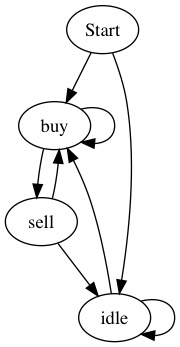题目
Your are given an array of integers prices, for which the i-th element is the price of a given stock on day i; and a non-negative integer fee representing a transaction fee.
You may complete as many transactions as you like, but you need to pay the transaction fee for each transaction. You may not buy more than 1 share of a stock at a time (ie. you must sell the stock share before you buy again.)
Return the maximum profit you can make.
Example 1:
Input: prices = [1, 3, 2, 8, 4, 9], fee = 2
Output: 8
Explanation: The maximum profit can be achieved by:
Buying at prices[0] = 1
Selling at prices[3] = 8
Buying at prices[4] = 4
Selling at prices[5] = 9
The total profit is ((8 - 1) - 2) + ((9 - 4) - 2) = 8.
传统动态规划
这是我第一个版本的答案,方法是对的,可惜需要n^2的时间复杂度,在leetcode上提交直接超时了。
具体思路就是:profit[i]这个状态的值由 (profit[0],… profit[i-1]) 到profit[i]的状态转变的最大值决定,即:
profit[i]= max{profit[0]+max{0, prices[i]-prices[0]}, ..., profit[i-1]+max{0, prices[i]-prices[i-1]}}
代码如下所示:
public static int maxProfit(int[] prices, int fee) {
int profit[] = new int[prices.length];
for(int i=1; i<profit.length; i++){
for(int j=0; j<i; j++){
int tmp = prices[i]-prices[j]-fee>0?prices[i]-prices[j]-fee:0;
if(profit[j]+tmp>profit[i]){
profit[i]=profit[j]+tmp;
}
}
}
return profit[profit.length-1];
}
状态机
这个方法是看了leetcode-309的状态机解法之后受到的启发。
通过分析,我们可以发现总共有三个状态:已买入(S0),已卖出(S1)和空闲(S2)。已买入状态的入度为:由已买入状态自我维持,或由已卖出状态转入,或有空闲状态转入。已卖出状态只有由已买入状态转入,因为有买才有卖。空闲状态可以由已卖出状态转入,或由空闲状态自我维持。开始状态,即对应第一个price,可以是空闲状态或已买入状态。所以状态转移图为:

买入时profit会降低相应的price,而卖出则会赚到相应的差价,所以状态转移函数为:
s0[i] = max(s0[i-1], s2[i-1]-prices[i]);
s0[i] = max(s0[i], s1[i-1]-prices[i]);
s1[i] = s0[i-1] + prices[i] - fee;
s2[i] = max(s1[i-1], s2[i-1]);
所以代码就如下所示了:
public static int maxProfit(int[] prices, int fee) {
int s0[] = new int[prices.length];
int s1[] = new int[prices.length];
int s2[] = new int[prices.length];
s0[0] = -prices[0];
s1[0] = -fee;
s2[0] = 0;
for(int i=1; i<prices.length; i++){
s0[i] = Math.max(s0[i-1], s2[i-1]-prices[i]);
s0[i] = Math.max(s0[i], s1[i-1]-prices[i]);
s1[i] = s0[i-1] + prices[i] - fee;
s2[i] = Math.max(s1[i-1], s2[i-1]);
}
return Math.max(s2[prices.length-1], s1[prices.length-1]);
}